If you’re wondering how Tripawd dog leg prosthetics work, prepare to learn from two experts! Welcome to the second part of our Tripawd Talk series with OrthoPets’ founder Martin Kaufmann. Today, you’ll get the real story about prosthetic legs for amputee dogs. Introducing Boris and his mom Tara from Dubai in the United Arab Emirates.
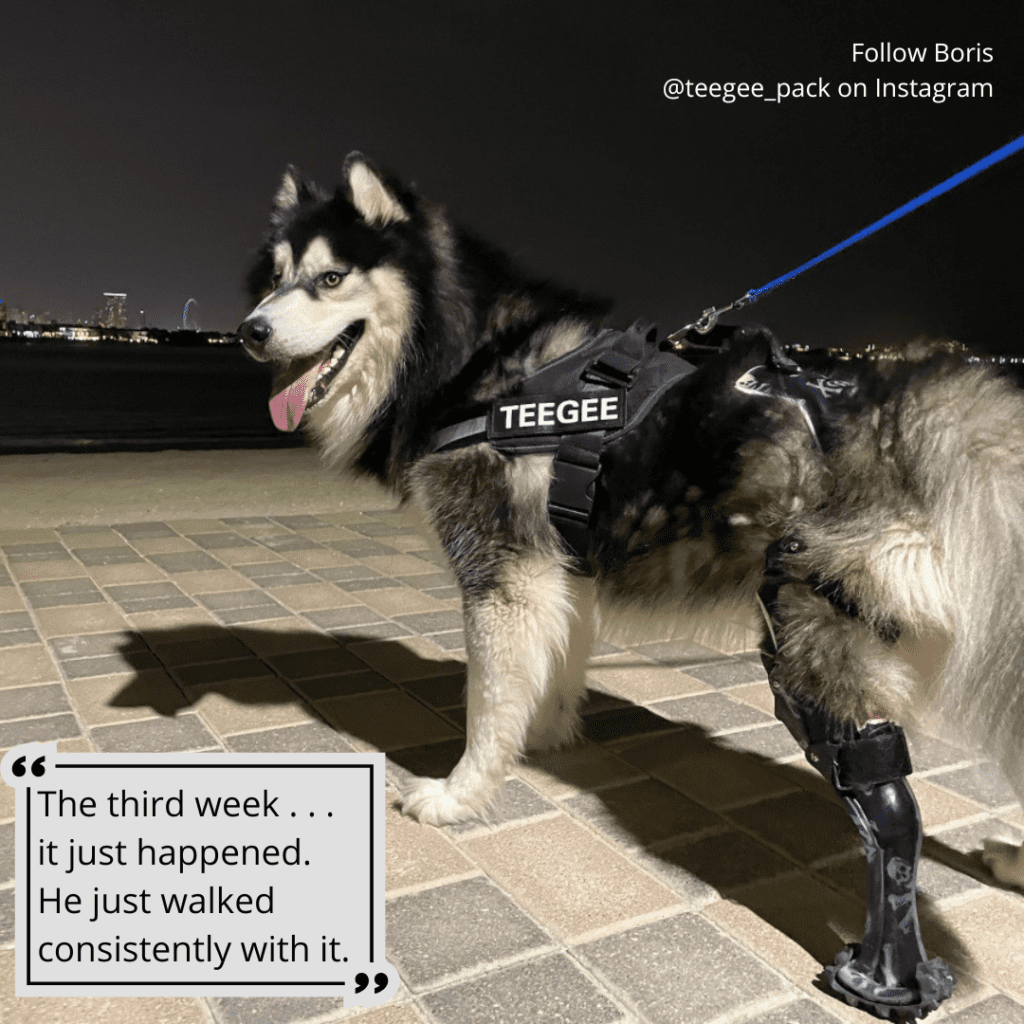
Catch Part 1 with OrthoPets & Boris
Is a Tripawd Prosthetic in Your Pet’s Future?
Watch & Learn About How Tripawd Dog Leg Prosthetic Work
On this episode of Tripawd Talk, Tara and Martin explain the process behind his OrthoPets prosthetic leg. Tune in to find out:
- How Boris got his prosthesis after a partial leg amputation
- Things to consider about dog prosthetics
- What it’s like to train a three-legged for prosthetic leg use
- Potential prosthetic roadblocks for amputee dogs
- The benefits of prosthetic legs for three-legged dogs
- And more!
Download This Tripawd Talk Radio Episode to Listen on the Go
Watch Tripawd Talk with Boris on YouTube
Catch Part 1 with OrthoPets & Boris
Is a Tripawd Prosthetic in Your Pet’s Future?
Read the Full Tripawd Talk Transcript: Boris’ Tripawd Dog Leg Prosthetic Experience
We are excited to continue our discussion about prosthetics for amputee pets with OrthoPets Founder, Martin. We now have Tara with us to provide a pet parent perspective on prosthetics for tripawds. Her husky, Boris, is a happy canine customer, loving life on three legs with help from a custom-made rear limb prosthesis made by OrthoPets.
Tara and Boris are joining us from Dubai in the United Arab Emirates proving that OrthoPets is a world leader in veterinary orthotic devices. Be sure to catch Episode #112 where we talked in more detail about the latest developments in pet prosthetics and we look forward to hearing about Boris and how his is working out. So thank you both once again for joining us.
- [0:01:44] How Boris the Tripawd Lost His Leg
- [0:03:35] The Tripawd Prosthetic Research Begins
- [0:04:15] Boris Has Amputation Surgery with a Prosthetic in Mind
- [0:06:11] The Reality of Tripawd Prosthetic Training
- [0:08:53] Look for the Possibilities Before Amputating
- [0:10:02] The Challenge of Some Tripawd Prosthetic Cases
- [0:10:48] How Almost Any Tripawd Can Learn to Use a Prosthetic
- [0:12:18] Tripawd Prosthetic Roadblocks
- [0:13:13] A Day in the Life of Boris, Tripawd Prosthetic User
- [0:15:42] Understanding Boris’ Reactions to the Prosthetic
- [0:16:25] Measuring Quality of Life for Tripawds Prosthetic Users
- [0:17:43] What Pet Parents Need to Know About Tripawd Prosthetics
- [0:19:40] Can Three-Legged Dogs Do Fine without a Prosthetic?
- [0:21:12] Why Not Restore Four-Legged Mobility in Dogs?
How Boris the Husky Lost His Leg (and got one back!)
[0:00:38] Welcome back to Tripawd Talk Radio Episode #113.
[0:01:27] Martin: Pleasure to be here.
[0:01:29] Tara: Pleasure to be here too.
[0:01:32] TRIPAWDS: Tell us a little bit about how Boris joined your family and the reason for his amputation.
[0:01:44] Tara: OK. So Boris is a husky. He is now almost 2 years old. He joined our family because we already had his brother, so his brother, Igor. And the place where we got Igor from, we sort of visited again after a while and we saw that they still have Boris and then my mom was basically looking and she is like, “Oh my God! He’s so cute. He looks so lonely and he is so sad.” So we took him home, right? So yeah, that’s how we got him.
Hard Decisions And Research After a Bad Accident
Then the reason he lost his leg or how he lost his leg is because we had 6 huskies at the time and Boris and one of our other huskies who has since then passed away gone into a fight and then we tried to separate them and when we separated them, Boris hit his leg against like the edge of a wall and it was such a dumb accident because what the vet told us afterwards, if he would have just hit it a little bit at a different place, he would still have his leg but it hit him right in the artery and we didn’t know that time.
So we thought, OK, it’s just a bruise because dogs get into fight and they will have bruises and then they heal and then you move on at the time and they’re jumping around and they’re going crazy again. He started getting really quiet.
And we thought that was the same things with Boris. We were just like, OK, he will be fine. And he was fine at the beginning so he walked from the leg and everything. But then sort of the next day, he started getting really quiet and didn’t really eat anymore and he just lay, which was such an un-Boris thing to do because Boris is loud and he walks around and like moves constantly.
Learning How Tripawd Dog Leg Prosthetics Work
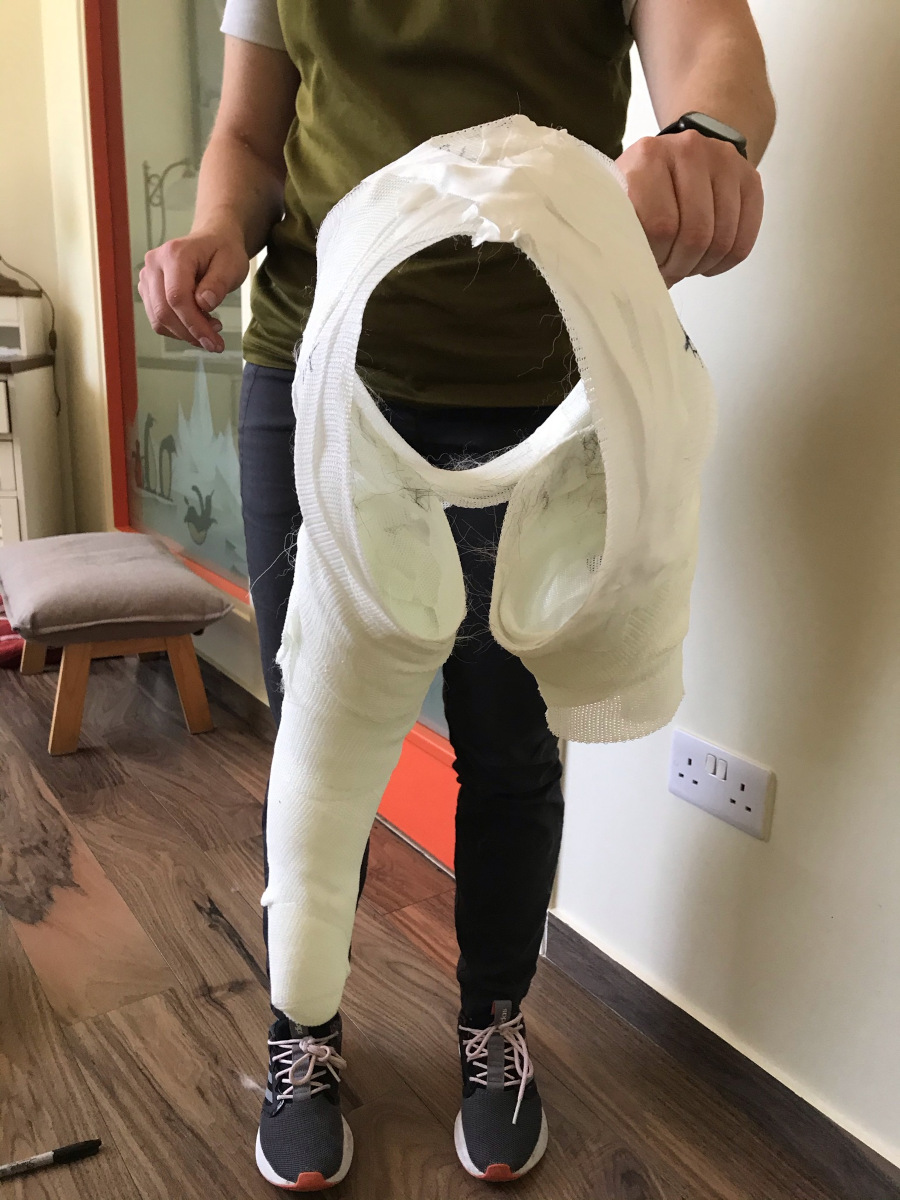
So then we went to the vet and then yeah, sadly, the vet told us that he hit his artery right there and they had to amputate the leg. And then at first, they wanted to amputate the whole leg and then we sort of started saying OK but isn’t there a possibility that he could get a prosthetic because we sort of know it for humans, right?
We sort of searched it up and then we didn’t actually find anything at the beginning. We were like, we were not active enough. And then we saw OrthoPets like their website and everything and we thought, OK, we would get in touch and say:
“OK, we have a husky and he is about to amputate this leg and could you do anything about it?”
Boris Has Amputation Surgery with a Prosthetic in Mind
And while that was going on, we were sort of talking to the vet because he was like, “I need to do the surgery.” And we were like, “OK, but can you amputate as little as possible?” He was like, “I have to see.” So he did an x-ray and he had a look and he was like, “OK. I can amputate it just below the knee.” And that is sort of the application we have now.
With OrthoPets, the rest just happened.
They sent the kit, and the vet did it for us. Then they sent the prosthetic. That’s sort of how Boris had his prosthetic.
And at the beginning, it was like – until we had the prosthetic, he got used to just hopping around with three legs. And so at the beginning, he was sort of getting used to walking with four legs again. I mean hop around and he just sort of drag his prosthetic leg along with him.
But then like we started to put it on more and he realized, “Oh, OK. I can walk on that leg. I can stand up again. I can jump!” And the good thing is we had other huskies at the time and so we want them to play. Sometimes when they’re playing, he sort of forgets that it’s a prosthetic and then he just started using it like:
“Oh yeah, look now! I can stand. Now I can light and with the others.”
Then he sort of just snapped and then he just walked with it constantly. Now, he has been running with it so it’s still a little bit of getting used to so he still sort of walks and then runs and then hops and then runs. But he is getting better at it.
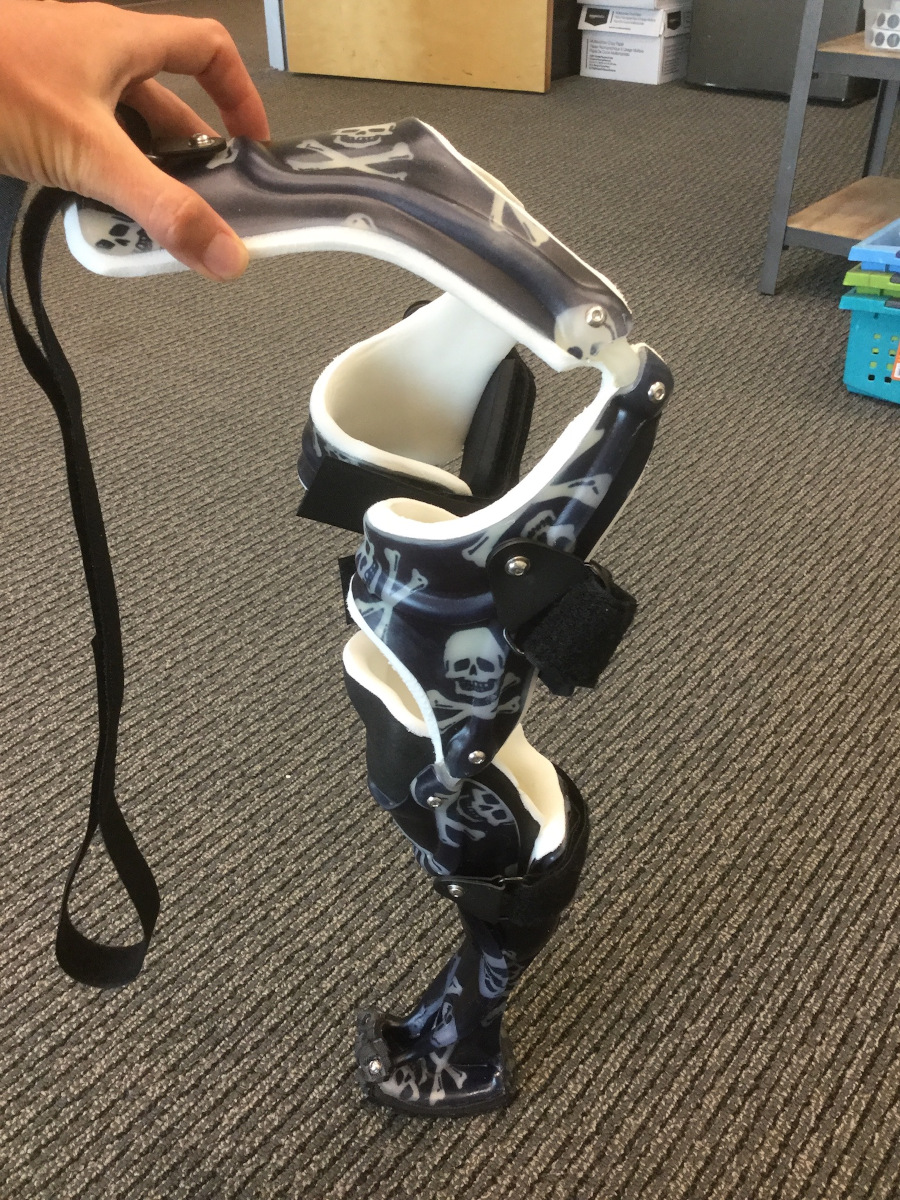
[0:05:53] TRIPAWDS: Were you in Dubai at the time throughout this whole process?
[0:05:57] Tara: Yes, we were in Dubai the whole time.
[0:05:59] TRIPAWDS: So Martin, you work with veterinarians anywhere in the world?
[0:06:03] Martin: Yeah, absolutely. The distance and the location is not a constraint in any way.
Training a Three Legged Dog to Use a Prosthetic Leg
[0:06:11] TRIPAWDS: Was there a certain time period where you were doing certain rehab and training to get him used to it?
[0:06:32] Tara: Yeah. The first week was really difficult. So the first week was really like, OK, show him that he has his legs so he would move the prosthetic along with him when would walk and then sort of lift one front paw put down and the other front paw.
Then sort of once – at the end of that week, we lifted the leg he still had and then he had to stand on that prosthetic leg. And at first, he didn’t like it at all. He was like, “No, I’m not going to stand.” But then yeah, sort of he got used to it.
Three Weeks to (Mostly) Full Use of His Leg
The second week was sort of when he slowly started to walk with it. So he walked a little bit and then hopped and then walked a little bit and then hopped. The third week, it was just – I don’t know, it just happened. He just walked consistently with it.
But then the problem was he sort of got stuck in the furniture so he ran around and he used his leg in the furniture and then he came back and his leg dangling on the – I mean he was like, “Help!” But now, he has gotten pretty good so he can like sort of maneuver around the stuff and remember to tuck it in when he needs to.
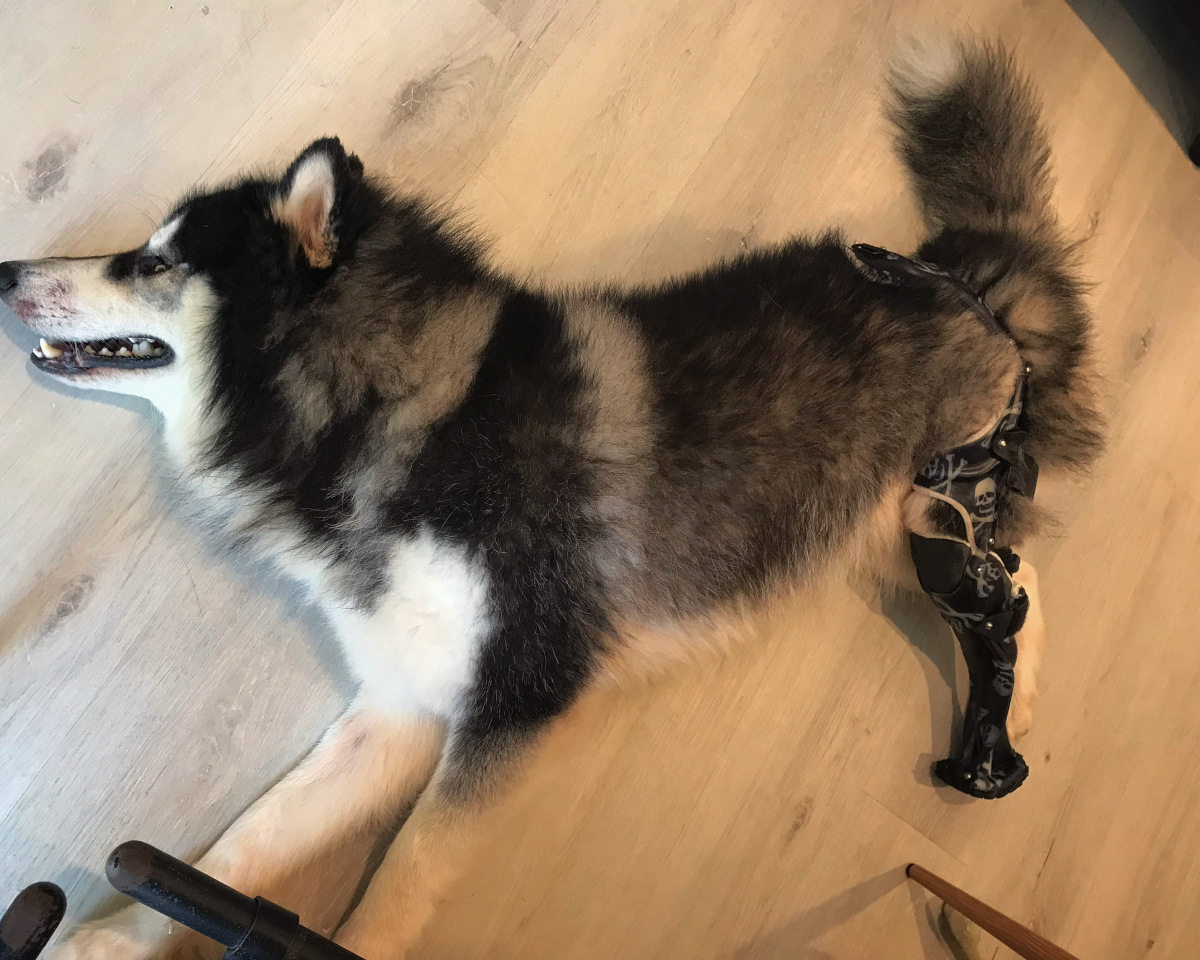
Tripawd Dog Leg Prosthetics are Not Magic Bullets
[0:07:37] TRIPAWDS: But it does take some time, effort, and training. And the pet parent needs to be really involved. This is not a magic bullet. You’re not going to attach a device and they’re going to go around and play fly ball, which no Tripawd should ever do anyway.
[0:07:49] Tara: Now, that wasn’t the case with Boris. He is just pretty active. But he still had to learn it and sort of readopt himself to using it. He doesn’t like to sort of change when you take it off but sometimes you have to take it off. And then he is like OK and then he hops around. And then you put it back on and then he is like, “OK, I can still hop but I have a leg. OK, now, no more hopping now, walking,” so yeah.
[0:08:15] TRIPAWDS: What was the length of time between when the vet told you that the leg needed to be amputated to the time the actual surgery took place?
[0:08:31] Tara: It was less than a day. It was less than half a day. I don’t have the time but yeah, it was sort of – he told us in the afternoon and then we were like, “Huh?” And then yeah, we sort of spent the afternoon to night looking it up and we were like, “OK, prosthetic is possible. Needs little surgery.” Told them like the morning and he said, “OK.” And then he sort of did it.
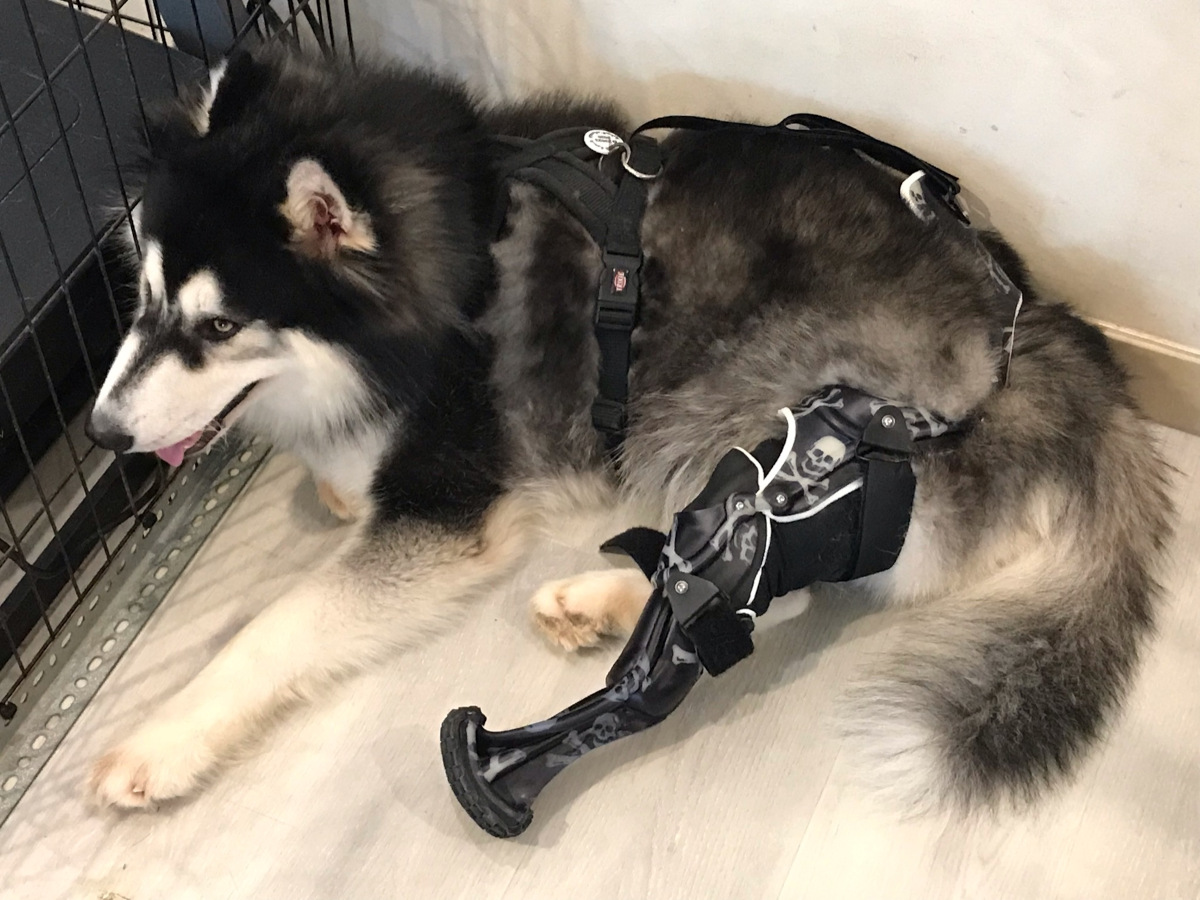
Why You Should Discuss the Possibilities Before Amputating
[0:08:53] TRIPAWDS: So this took some quick thinking. So for anyone listening, if you do have the luxury of time, do your homework. Listen to some podcast here and ask those questions of the vet.
[0:09:04] Tara: Yeah. And definitely like – because most of the vets would not tell you at the beginning that you need that you have a possibility of a prosthetic. They will just tell you “OK, you need to amputate it.” And then you sort of have to go on by yourself and be like, “Oh, OK. There is a possibility.” And then when you tell the vet, “Look, there is a possibility,” they would go like, “OK, there is a possibility and this is what we can do.” That’s at least how it is in Dubai.
[0:09:31] TRIPAWDS: No. It’s like that here too. Now, had your veterinarian ever worked with a prosthetics manufacturer before?
[0:09:39] Tara: He actually did. So he worked with OrthoPets as well for a dog but he was a small one he lost his front limb, part of it at least.
[0:09:51] TRIPAWDS: So interestingly enough, so that veterinarian was still going to just do the full amputation just like that on the fly? Martin, do you see that happen a lot?
The Challenge of Some Tripawd Dog Leg Prosthetics Cases
[0:10:02] Martin: I do. The Boris who you’re seeing today represents one of the most challenging prosthetic cases that you could possibly come up given the level of amputation and the challenges of that device. We think it’s looking pretty normal and simple but when you actually see the background, a veterinarian who has some experience with a very low level amputee and prosthetic would look at a Boris case and would not be able to conceptualize that it is also a prosthetic candidate. So we are back to that research that we published to add that level of certainty and in this case, opportunity or possibility.
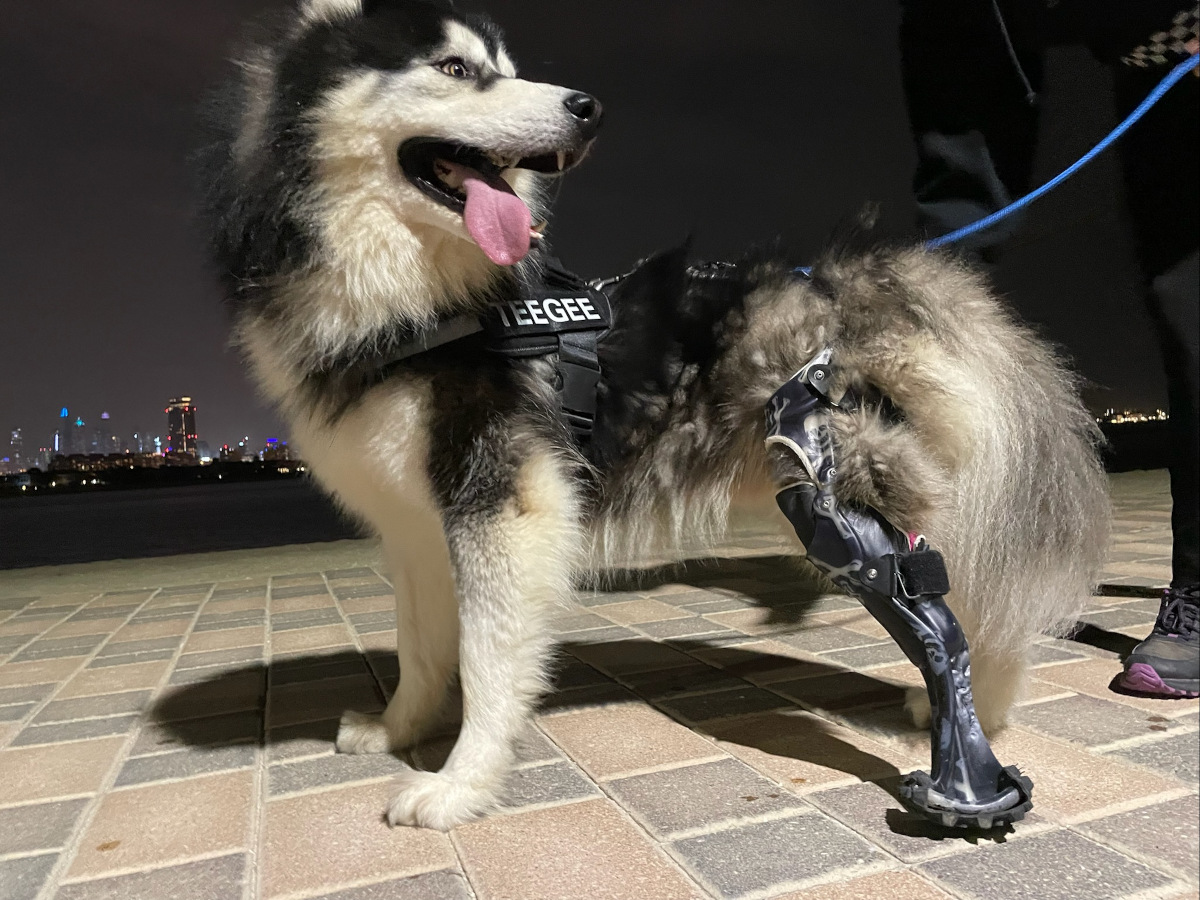
How Almost Any Tripawd Can Learn to Use a Prosthetic
[0:10:48] TRIPAWDS: Is there any time when it’s too late to do a Tripawd dog leg prosthetic? Can you take a 6-year-old Tripawd who has been one all their life and put a prosthetic on and achieve success? Assuming they have a residual limb.
[0:11:35] Martin: Yup. And the same – so a couple of answers here. We call it productive struggling. When you first get your device and you’re trying to figure it out and nobody told you why this thing is on your body to even start, but productive struggling.
So really what we are going to say is, whether you are a Tripawd from amputation 6 years ago or you are born with as we were joking earlier, the flipper, if you’re born missing parts, either way, with rehabilitation therapy, sports, medicine, prosthetics, it’s the cliché but all things are possible. And the question really is, how long is it going to take you to learn?
Tripawd Prosthetic Roadblocks
[0:12:18] TRIPAWDS: So the things that come to mind are time, cost, and effort involved in rehab and training. Are these the primary roadblocks to educating the pet parent in willing to proceed with prosthetics?
[0:12:32] Martin: If we put the cost piece on the front, once we’ve experienced what the costs both the device but also surgery, when we understand that and we have that feasibility then we move on to this is now in running terms, this is the third shoe for you.
It’s a thing that your maintenance and it’s a thing that you work with on a daily basis. So there is a time commitment. I’m sure as Tara can tell, it’s not that you just toss it on and then forget about it. You’re invested in the quality of life of your pet.
A Day in the Life of Boris, Tripawd Prosthetic User
[0:13:13] TRIPAWDS: Tara, can you give us like a day in the life of Boris from the time he wakes up to the time he goes to bed, how involved are you in the device? Also discuss the quality of life that Martin just mentioned. How is the device helping that?
[0:13:31] Tara: So basically in the – so when he sleeps, he takes it off so he didn’t wear it. And then in the morning, we usually put it on. And then he will run around, walk and stuff with his prosthetic. And then sort of at lunchtime, we sort of take it off.
When he is tired, we take it off. He doesn’t particularly nice in keeping with it so he gets so uncomfortable.
He can’t freely lay on it. He can lay on it. He just sort of pushes into his back and he doesn’t sleep well when he does that. So we take it off and then he sleeps a little. We just sort of leave it off until the afternoon. And then the afternoon, early afternoon, so we try – and then he puts it back on and they will just run, play, and do this normal stuff. So we put it on a lot but when he sleeps, we take if off because, yeah, he doesn’t like it.
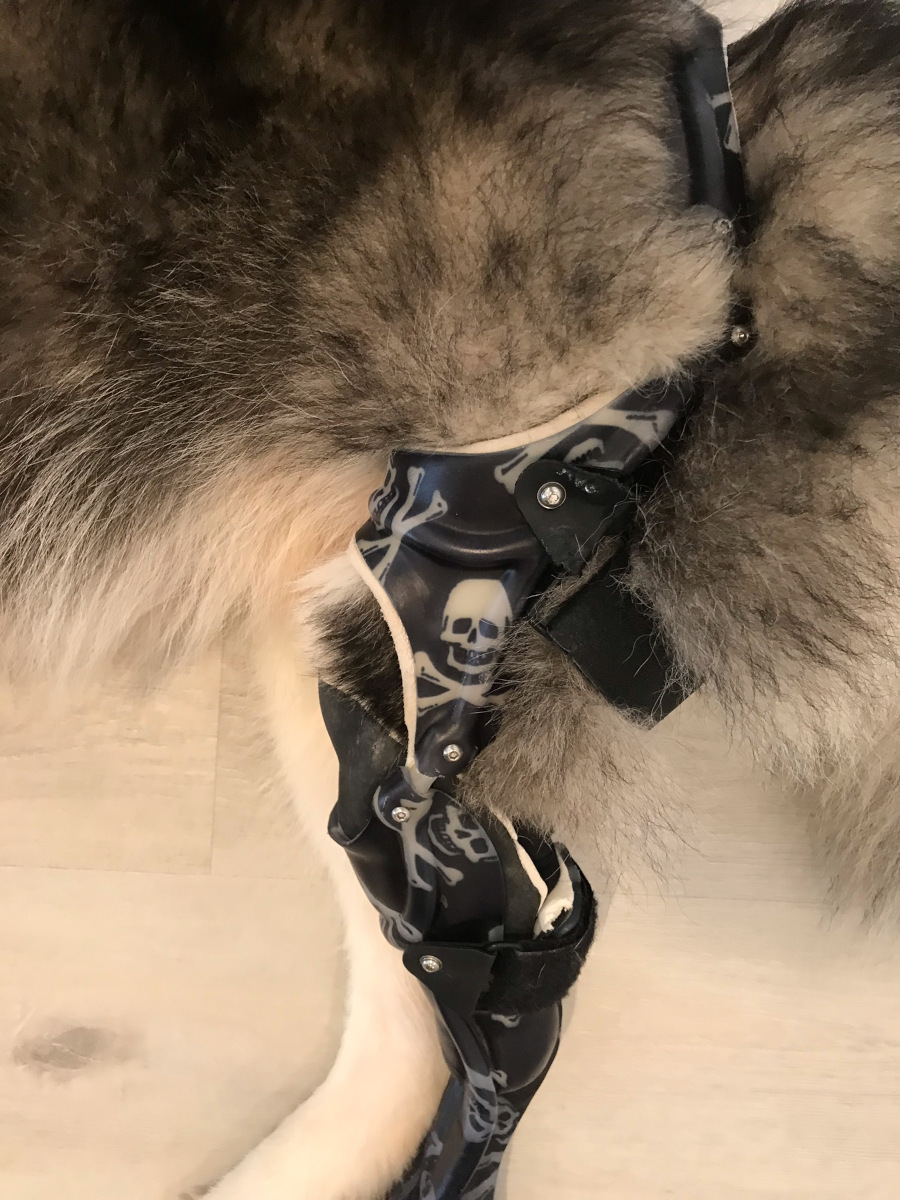
[0:14:28] TRIPAWDS: How much time does it actually take you to put it on him?
[0:14:36] Tara: That depends entirely on Boris because if he is not – when he is super cooperative then it goes like a minute and it’s on and you’re like off you go. And there are times when he is like, “No, I don’t want to put it on. I want to play. I have a thing to do.”
Ghen you’re like – he kind of moves around and you have to chase after him or he will just sort of pull his leg and he is like, “Nope, I’m not giving it to you.” And then you can’t put it in. You’re just like, “I’ll give you a treat if you put it down.” And he says, “No.” He is like, “Give us treat.” And then you just walk off. Yeah. So it entirely depends on how Boris is feeling about it.
Understanding Boris’ Reactions to the Prosthetic
[0:15:42] Tara: Yeah. It’s really like that. It’s also sort of understanding him and understanding how he deals with the prosthetic and like what occurs, when does it hurt, like what makes it feel uncomfortable. It’s because it goes over that and to part of his other legs so his other legs can move as well. You have to make sure not to make it too tight or that it’s something that he doesn’t like then he will just stand there like this. And then you’re just like, “OK, something is wrong.” And then you take it off and put it back on.
[0:16:18] TRIPAWDS: Now, you are so well-versed in the process now. How did you learn how to do this?
Measuring Quality of Life for Tripawds Prosthetic Users
[0:16:25] Tara: In the beginning, it was really difficult but not really because there is a pamphlet where they show you how to put it on in pictures, which is wonderful. But that would only work if the dog was cooperating, right? So they cooperate and you are like, “OK. But you have to put those legs down.” He’s just like going there and then he is like, right?
It’s a struggle in the beginning like three people have to stand around him to just like strap each part to him and hold him and like treats and like everything. Now, it’s just like one person does it. He grabs Boris, put it on his leg and then off he goes. It’s practice really.
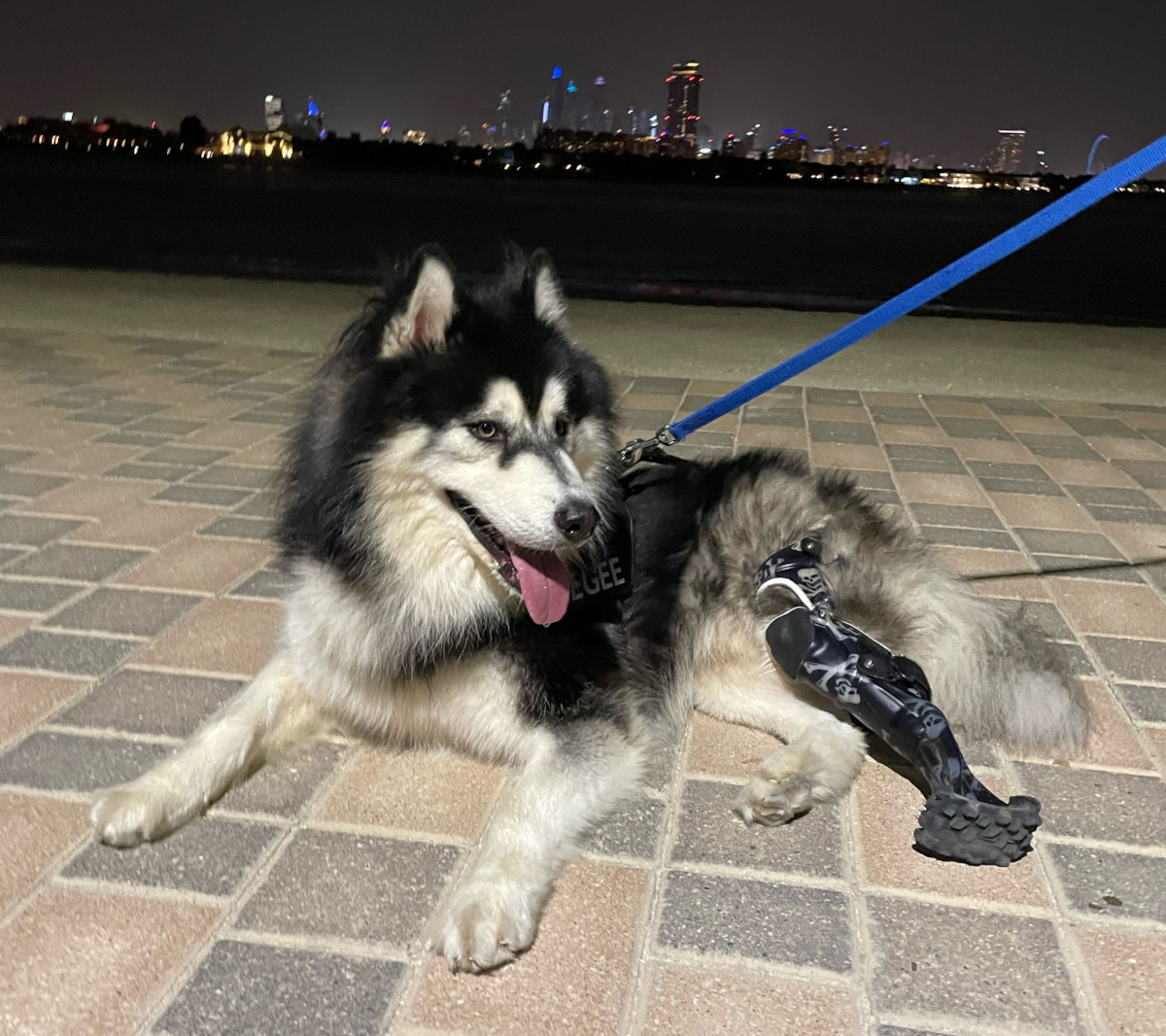
[0:17:03] TRIPAWDS: Does this device allow you to go on longer walks or allow him to go free play more frequently or longer?
[0:17:14] Tara: Yeah, it does. So he can walk just as long as the other huskies we have who have all legs and he can play with the others especially when he has that prosthetic on, we have a girl and she loves to stand on, on the other ones and that’s her form of playing.
When he doesn’t have his leg, he sort of always falls down and be at a disadvantage. But now with his leg, he is like, “No, I can stand. I’m going to play with you.” So it’s really – yes, it’s amazing for him.
What Pet Parents Need to Know About Tripawd Dog Leg Prosthetics
[0:17:43] TRIPAWDS: Martin, what is the ideal frame of mind for a human, a pet parent who is thinking about this? How would you describe the ideal pet parent candidate?
[0:18:13] Martin: Yeah. And I will maybe answer this as what we were just discussing. Boris is doing things with his friends and play for quality of life. But it also means that we are thinking long term. We are thinking about the accumulation of effects. And I think that’s the motivation for us as pet parents when we are in the – when we have the privilege to make a decision for prosthetics because it allows us to.
The Ideal Pet Parent is Actively Engaged in their Tripawd’s Quality of Life
The ideal pet parent is someone who is active with their pet or like their pet to remain active and is looking to make a positive and long term quality of life in pet. And I think that really speaks to the individual.
There are probably some technical things like you’re not overly concerned about pulling straps through a buckle. Or you feel comfortable holding the limb that has been partially amputated. If there are some things here that might show up for the individual pet parent. But you are vested in comfort and function. And if that’s you as a parent and that’s what you want for your pet, prosthetics is just an exciting way that you get to do it every single day. You get to be the one to administer this health care. You get to be the doc if you will to do this for your pet.
Can Three-Legged Dogs Do Fine without a Prosthetic?
[0:19:40] TRIPAWDS: What would you tell people out there who are providing advice to people questioning prosthetics that just say, “Oh, he doesn’t need it, he will be fine?”
[0:20:15] Tara: Yeah. I understand them because sort of a couple of weeks ago, Boris started to be able to stand out of prosthetic as well. So he would be able to stand on stuff that was higher than him and he is starting to adopt better and just not having that leg. And you would look at him and you’re like, “Whatever. Fine. He is doing stuff that he likes to do and he is happy.:
But then you sort of compare it to when he is wearing his prosthetic and it’s just like it gives him that extra security, that extra ability and stability to do things. I always say like, “Yeah, I understand your dog OK, has three legs, he is doing well. And Boris is doing well too. But trust me when I say that when you put on that leg, it’s just like – it’s like having his leg back.”
It’s amazing. It’s like it will not be hard. It’s not hard for me putting it on. They are literally, “Oh, my leg is back. I’m excited about this.” So yeah.
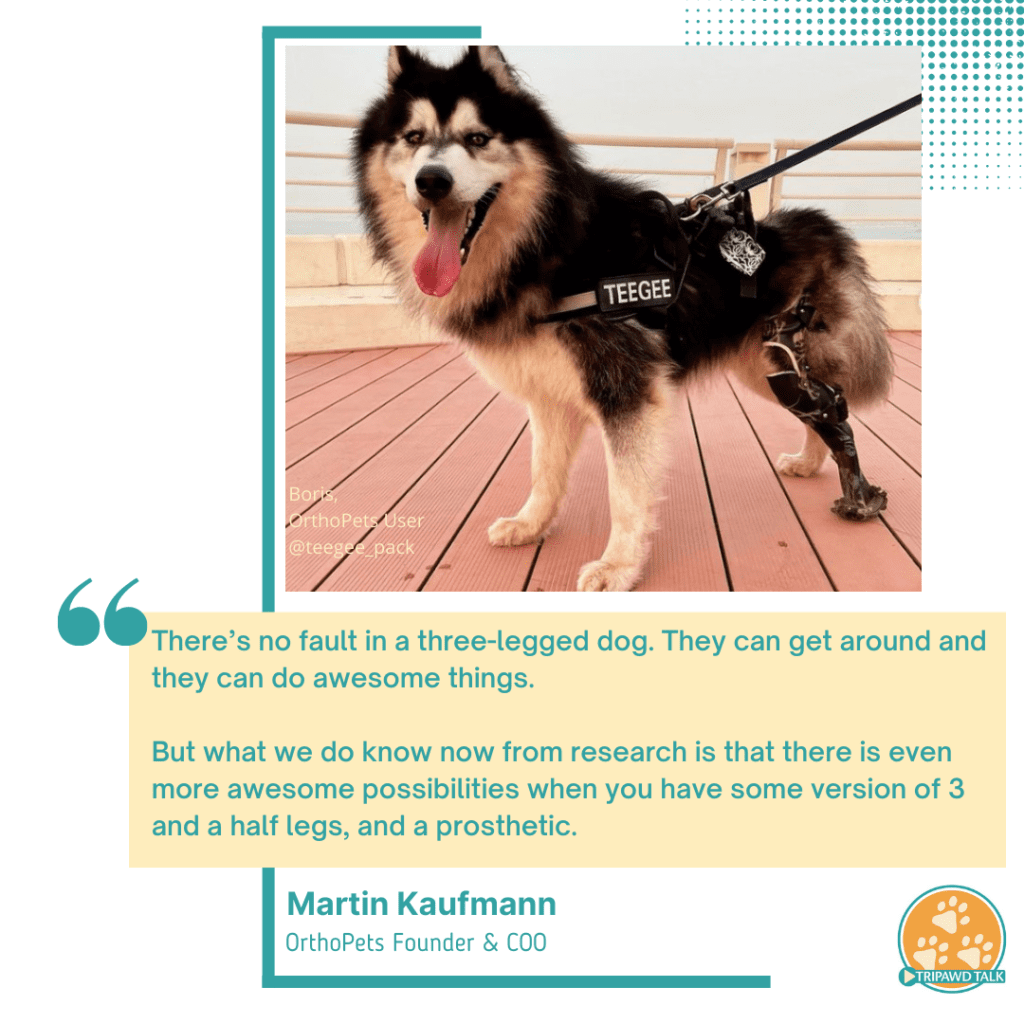
Why Not Restore Four-Legged Mobility in Three Legged Dogs?
[0:21:12] TRIPAWDS: Would you say the long term benefits are most important or what would you tell those people that say, “Oh, he doesn’t need it, he will be fine?”
[0:21:19] Martin: Yes. So I’d like to live without compromise in my personal life. I bring that same passion to what we do here.
Our dogs and cats, they’ve been designed for four legs. So if we don’t have to compromise on that, that’s prosthetics. That’s comfort and functioning. So we can’t negotiate that. We are designed to have four legs.” So if we can’t then our goal should be in my opinion, to restore in that compromise in return to four legs. And I think Tara and Boris are great examples of just the truth in that. We can’t negotiate that topic.
Prosthetics Help with Long Term Comfort and Function
Now, for our pet parents who have to make the really hard choices of full limb amputations, now there’s a whole another talk on, now we are compromising. And how do we reduce the impact in the long term? Because we can’t escape that. Gravity on earth doesn’t change. Thermal dynamics are present. So there is an accumulation of costs. So how do we adjust and take away freedom and function because at the consequences that are accumulating over time, in prosthetics, we don’t compromise there so we can enjoy the long term success of comfort and function.
[0:22:37] TRIPAWDS: Thanks to you and the forward-thinking orthopedic vets that are out there and general practice vets who are now discovering the benefits of prosthetics. Three-legged dogs and cats’ lives are getting better and better all the time.
Thank you for what you are doing, Tara. Thank you for being a great example to people who are in this situation where they have to decide.
[0:23:40] Tara: Perfect. Thank you for having us, me and sometimes Boris!
[End of transcript]
my lab lost his total rear leg from the hip down. is there a prosthetic that actually works.
Hi Steve, sorry to hear about your pup. At this time, unless a dog has an articulating joint the way Boris does, there is no true prosthesis that will attach to the body. However, what will help is rehab therapy and good activity choices to keep him strong. You can even get your dog’s first rehab therapy visit reimbursed by Tripawds Foundation. Please join us in our Discussion Forums so we can help you better OK?
I’ have 2 tripawd dogs now. At one time we had 4. They are just amazing. Reading was very helpful, but I’m still trying to figure out how a prosthetic is used on a tripawd who doesn’t have a stump.
Thanks for posting Tricia! We have been told by ortho vets and rehab therapists that attaching a true prosthetic to anything less than a limb with two joints remaining is not possible at this point in time. There are some devices out there being called prosthetics, but they are more of a support brace than a true prosthetic that has articulating movement.